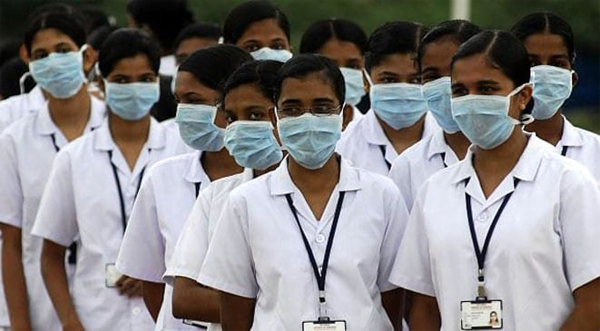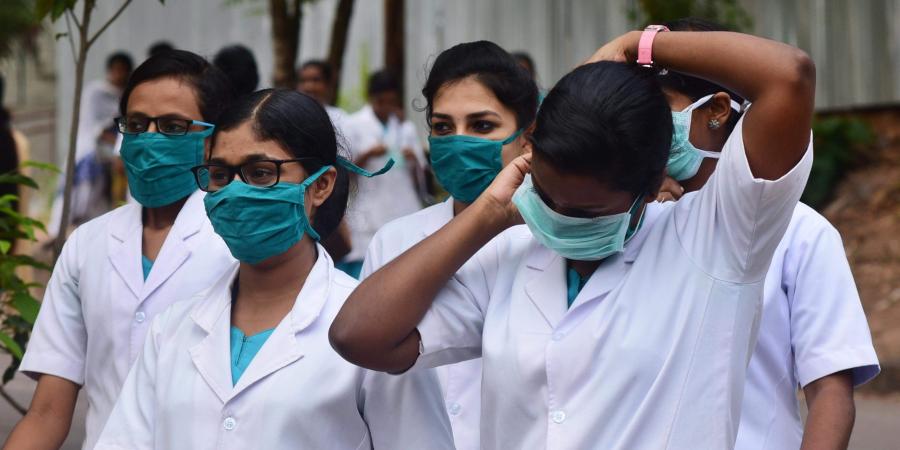In these aggravated times, when shortage of #nurses cripples #Mumbai and #NewDelhi hospitals, the #nurses and ANMs, working on a temporary basis staged a #protest at the Collector’s office in Andhra Pradesh on 30th November. They have further urged the #government to regularize their #services since they had worked to save lives of patients in #COVID-19 hospitals.
During the protests, they demanded for an immediate payment of pending salaries for the last six months. They said that the government had issued orders for their termination with the drop in new cases in the last two months. On being questioned by the media, the Collector assured that the payments would be done very soon for all the nurses and ANMs. Furthermore, the government’s guidelines would be followed in continuation of their services.
Ironically to the tensed situation, the year 2020 had been designated as “#International Year of the #Nurse and the #Midwife”. India’s nursing workforce is about two-thirds of its total #health workforce. However, its ratio of 1.7 nurses per 1000 population is 43% less than the #WHO norm. In addition to that, the sector has been facing structural challenges leading to poor quality of #training, #inequitabledistribution, and #non-standardized practices.
Almost 91% of the nursing education institutions in India are private and weakly regulated. Its uneven and weak regulation has deteriorated the quality of #nurse-training process. The current nursing #education and curriculum are #outdated and fail to cater to the practice needs in the current times. There are insufficient postgraduate courses to develop skills in specialties, and address critical faculty shortages both in terms of quality and quantity. These factors have led to gaps in skills and competencies, with no clear career trajectory for nurses.
The Hindu has suggested that initiatives like conducting a common entrance exam, a national license exit exam for entering into practice and a periodic license renewal would also strengthen the nursing sector in India. Moreover, the unequal distribution of nursing centres across India is making it more inaccessible for people. Around 62% of them are situated in #SouthIndia.
Lack of #JobDifferentiation

There is a lack of job differentiation between diploma, graduate, and postgraduate nurses regarding their pay, parity, and promotion. Those with advanced degrees prefer to migrate abroad where their qualifications are recognized. This has led to an acute dearth of qualified nurses in the country. The #IndianNursingAct primarily revolves around nursing education and does not provide any policy guidance about the roles and responsibilities of nurses in various cadres.
Nurses in India have no guidelines on the scope of their practice and have no prescribed standards of care. This may endanger patient safety. It is a major reason for the low legitimacy of the nursing practice and the profession. Another example proving the inconsideration to the nursing sector is the #ConsumerProtectionAct, which protects the rights and safety of patients as consumers, holds only the doctor and the hospital liable for medico-legal issues; nurses are out of the purview of the Act. This is contrary to the practices in developed countries where nurses are legally liable for errors in their work.
The Gendered #hierarchy of the job

The relationship between doctor and nurse is not that of collaborators or equals but that of superiors and #subordinates, further reflected in the #GenderedWageGap and adverse working conditions.
#Corporatisation and #privatisation of healthcare has led to further exploitation of nurses and nursing ancillary staff. With international #immigration, there has been a supply crunch in nursing labour and this scarcity of registered nurses, instead of valorising nursing #labour, has led to an increase in the hiring of unregistered nurses, nursing aides and attendants.
The nursing labour market is a pyramidal market with the bottom over-represented by female casual employees struggling with low wages and status, #stigma, and no labour rights. The affective or emotional labour of nursing has always been downgraded in a highly #masculinised job market.
Prevalence of #casteism across professions
We live in a deeply casteist society where any labour that brings you in touch with the body and its detritus is considered polluting. This reflects in the way we treat the domestic worker, the nursing attendant, or the manual scavenger.
The challenging times COVID-19 has added to the miseries and difficulties of the nursing sector as most of them had to work non-stop and some even refrained from meeting their family members. As rightly said, these ‘#overworked, but #underpaid #nightingales’ certainly deserve much better in terms of their professional practice.
- Arishmita Aditya
- Silchar
Sources:
- https://m.economictimes.com/topic/nurses-protest?from=desktop
- https://www.thehindu.com/society/though-a-high-skill-job-nursing-remains-low-paid-and-stigmatised-panchali-ray/article32181653.ece
- https://www.thehindu.com/sci-tech/health/coronavirus-lockdown-home-nurses-cant-return-to-families/article31257350.ece
- https://www.thehindu.com/news/cities/bangalore/international-nurses-day-the-overworked-but-underpaid-nightingales-deserve-better/article7196598.ece
- https://www.thehindu.com/opinion/lead/a-sector-that-needs-to-be-nursed-back-to-health/article33322153.ece
Picture Sources:
- Q8India.com
- News Indian Express
- The Economic Times





















































































